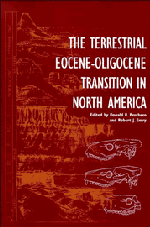Book contents
- Frontmatter
- Contents
- Contributors
- Preface
- PART I The Chronostratigraphy of the Uintan through Arikareean
- 1 Magnetic stratigraphy and biostratigraphy of the middle Eocene Uinta Formation, Uinta Basin, Utah
- 2 Biostratigraphy and magnetostratigraphy of the Bridgerian-Uintan Washakie Formation, Washakie Basin, Wyoming
- 3 Magnetic stratigraphy, sedimentology, and mammalian faunas of the early Uintan Washakie Formation, Sand Wash Basin, northwestern Colorado
- 4 Theoretical biochronology, the Bridgerian-Uintan boundary and the “Shoshonian Subage” of the Uintan
- 5 Middle Eocene mammalian faunas of San Diego County, California
- 6 Stratigraphy and paleomagnetism of the middle Eocene Friars Formation and Poway Group, southwestern San Diego County, California
- 7 Magnetostratigraphy of the upper middle Eocene Coldwater Sandstone, central Ventura County, California
- 8 Stratigraphy and paleomagnetism of the upper middle Eocene to lower Miocene (Uintan to Arikareean) Sespe Formation, Ventura County, California
- 9 Magnetostratigraphy of the Eocene-Oligocene transition in Trans-Pecos Texas
- 10 Magnetic stratigraphy of the Duchesnean part of the Galisteo Formation, New Mexico
- 11 Stratigraphy and vertebrate faunas of the Bridgerian-Duchesnean Clarno Formation, north-central Oregon
- 12 Eocene-Oligocene faunas of the Cypress Hills Formation, Saskatchewan
- 13 Magnetic stratigraphy of the White River Group in the High Plains
- 14 Magnetostratigraphy and biostratigraphy of the Eocene-Oligocene transition, southwestern Montana
- 15 The Whitneyan-Arikareean transition in the High Plains
- PART II Common Vertebrates of the White River Chronofauna
- Summary
- Index
7 - Magnetostratigraphy of the upper middle Eocene Coldwater Sandstone, central Ventura County, California
Published online by Cambridge University Press: 06 July 2010
- Frontmatter
- Contents
- Contributors
- Preface
- PART I The Chronostratigraphy of the Uintan through Arikareean
- 1 Magnetic stratigraphy and biostratigraphy of the middle Eocene Uinta Formation, Uinta Basin, Utah
- 2 Biostratigraphy and magnetostratigraphy of the Bridgerian-Uintan Washakie Formation, Washakie Basin, Wyoming
- 3 Magnetic stratigraphy, sedimentology, and mammalian faunas of the early Uintan Washakie Formation, Sand Wash Basin, northwestern Colorado
- 4 Theoretical biochronology, the Bridgerian-Uintan boundary and the “Shoshonian Subage” of the Uintan
- 5 Middle Eocene mammalian faunas of San Diego County, California
- 6 Stratigraphy and paleomagnetism of the middle Eocene Friars Formation and Poway Group, southwestern San Diego County, California
- 7 Magnetostratigraphy of the upper middle Eocene Coldwater Sandstone, central Ventura County, California
- 8 Stratigraphy and paleomagnetism of the upper middle Eocene to lower Miocene (Uintan to Arikareean) Sespe Formation, Ventura County, California
- 9 Magnetostratigraphy of the Eocene-Oligocene transition in Trans-Pecos Texas
- 10 Magnetic stratigraphy of the Duchesnean part of the Galisteo Formation, New Mexico
- 11 Stratigraphy and vertebrate faunas of the Bridgerian-Duchesnean Clarno Formation, north-central Oregon
- 12 Eocene-Oligocene faunas of the Cypress Hills Formation, Saskatchewan
- 13 Magnetic stratigraphy of the White River Group in the High Plains
- 14 Magnetostratigraphy and biostratigraphy of the Eocene-Oligocene transition, southwestern Montana
- 15 The Whitneyan-Arikareean transition in the High Plains
- PART II Common Vertebrates of the White River Chronofauna
- Summary
- Index
Summary
ABSTRACT
A magnetostratigraphic study was undertaken to improve the age control of the middle Eocene Coldwater Sandstone in southern California. The results show that, although magnetic overprinting is common in Coldwater rocks, most samples yield a stable characteristic remanence that passes reversal and fold tests and shows a clockwise rotation of about 100° ± 17° (consistent with other pre-Miocene units in the western Transverse Ranges). Magnetic stratigraphy and refined chronostratigraphy of the late Uintan and Duchesnean mammals found within redbeds of the Coldwater show that the upper Cozy Dell Shale-Coldwater Sandstone-Sespe Formation succession in central Ventura County spans Chrons C19r-C18n (approximately 39.5-42.5 Ma). These data do not corroborate the sequence stratigraphic interpretations of Campion et al. (1994) or Clark (1994). We suggest that local tectonic forces may have been more important than eustatic sea level fluctuations in causing sequence boundaries in the Coldwater and Sespe formations.
INTRODUCTION
The Transverse Ranges of southern California (Fig. 1) contain an important succession of strata that records a complex history of transgressions and regressions during the Eocene. In the upper Sespe Creek area of central Ventura County, over 4,800 m of Eocene strata were deposited, and some of these formations are even thicker to the east or west. The Eocene succession starts with the lower Eocene deep-water Juncal Shale, overlain by the middle Eocene shallow- to deep-marine Matilija Sandstone, and then by the deep-water Cozy Dell Shale (Kerr and Schenk, 1928; Page et al., 1951; Vedder, 1972; Dibblee, 1966, 1982; Jestes, 1963; Ingle, 1980; Campion et al., 1994).
- Type
- Chapter
- Information
- The Terrestrial Eocene-Oligocene Transition in North America , pp. 155 - 170Publisher: Cambridge University PressPrint publication year: 1996
- 1
- Cited by



